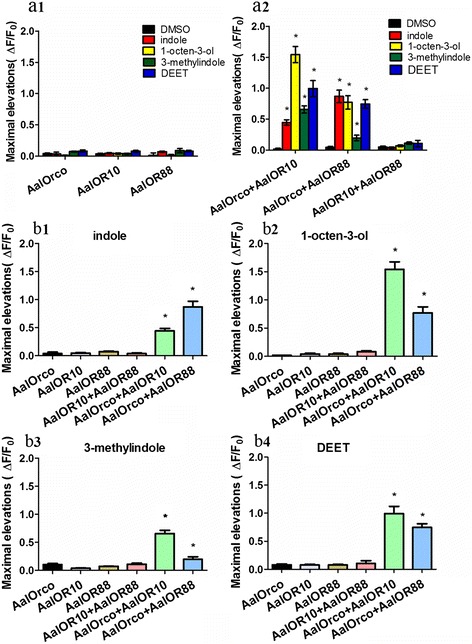Fig. 3.

Odorants activate calcium entry in HEK293 cells expressing AalORs. Ca2+ levels are represented as ΔF/Fo, where Fo is the baseline fluorescence signal intensity before stimulation, and ΔF is the difference in peak fluorescence caused by stimulation. The responses were quantified by the mean values of the maximal elevations (ΔF/Fo). The maximal intracellular calcium concentrations activated by indole (red), 1-octen-3-ol (yellow), 3-methyindole (green), DEET (blue), and DMSO (control, black) are provided. Maximal intracellular calcium concentrations occurred in HEK293 cells expressing AalOR7 (F (4,189) = 15.136, P < 0.0001, Dunnett T3 vs DMSO, indole: P = 1.000, 1-octen-3-ol: P = 0.128, 3-methyindole: P = 0.103, DEET: P = 0.310), AalOR10 (F (4,199) = 1.654, P = 0.162), AalOR88 (F (4,200) = 4.679, P = 0.002, Dunnett T3 vs DMSO, indole: P = 0.569, 1-octen-3-ol: P = 1.000, 3-methyindole: P = 0.549, DEET: P = 0.442) (a1) AalOR7+ AalOR10 (F (4,121) = 76.193, P < 0.0001), AalOR7+ AalOR88 (F (4,128) = 47.871, P < 0.0001), and AalOR10+ AalOR88 (F (4,151) = 1.733, P = 0.146) (a2) upon stimulation with indole, 1-octen-3-ol, 3-methyindole and DEET. The differences in single AalORs and complexes responding to the same odorant were analyzed: b1 Indole (F (5,197) = 27.481, P < 0.0001); b2 1-octen-3-ol (F (5,186) = 38.934, P < 0.0001); b3 3-methyindole (F (5,240) = 24.641, P < 0.0001); and b4 DEET (F (5,175) = 26.955, P < 0.0001). These results are representative of three independent experiments (one-way ANOVA test, Dunnett T3). Bars represent the means ± SD. *P < 0.05
